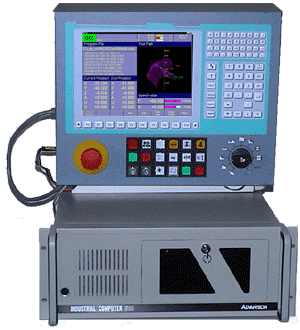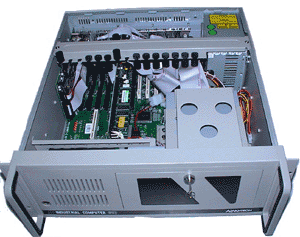|
|
Numerical Control System, WinPCNC General characteristics
The WinPCNC is a one-computer NC system, based on the mighty platform of the personal computer with the operating system Windows NT and VentureCom 4.1 real time extension. It belongs to the PCNC class, that is Personal Computer Numerical Control. This class of personal control systems is considered now to be the most perspective class of new-generation systems. He system uses the only processor, providing all necessary functions, including cycle logic. The hardware is submitted by the apparatus of the personal computer with additional interface modules for connections with servo-drives, spindle units, cycle-logic drives and the operator panel. All these devices are available today at the computer market; consequently, there is no necessity to organize some special production of numerical control systems. The view of the WinPCNC numerical control is shown in the Pic.1.

Pic. 1. WinPCNC numerical control system
Numerical control system consists of two independent blocks, the system one (at the bottom in the picture) and the operator panel. The system block is placed in the case of the industrial computer, which guarantees defense from any noise and disturbances. The operator panel should be enclosed in its own case in such a way, that it is convenient for the customer. The system block is opened in the Pic.2. It is some basic set of boards on the PCI bus. There exists a possibility to put in additional boards; for instance, in order to increase the number of axes controlled, to increase the number of parallel inputs-outputs of the cycle logic, to include Fieldbus interface net cards to control drives and cycle logic. Additional boards belong to NC options, defined by the customer.

Pic. 2. The system NC block
The open architecture
The special feature of WinPCNC system at the application level is its open architecture, which provides vast possibilities to adjust the system to requirements of both manufacturers and end users. Configuration and other additional software tools support these requirements. Thus, the operator interface is open to include any applications of the end user, implemented in the Windows environment. The large set of API interface functions (Application Programming Interface) is available for end users. The user interface (its design; its set of modes, pages and menus) could be substantially redesigned in the shortest time with the help of the special software tool, State_Machine_Builder. The NC system could be setup for any version of the flow program language, ISO-7bit (DIN 66025). The setup version is supported by both the editor-debugger of flow programs and the flexible interpreter of flow programs (ISO-processor). The interpreter is able to be setup for any considerable number of buffered blocks. The editor-debugger has the embedded system of graphical simulation at the input of the system and at the output of the interpreter, i.e. taking equidistants into account. The system interpolator has a flexible structure and a fixed input interface, IPD (Interpolator Data); it is open to include any special interpolation algorithms. In the process of control any combination of existing algorithms could be used. The flexible system of cycle logic is built on the SoftPLC concept; i.e. on the base of the software realization of PLC inside the application component of the Numerical Control System. All NC modules communicate through the multi-functional software bus. Which is the global system server. Such an organization makes it possible to scale the system.
Technical characteristics of the WinPCNC system
-
The computer type and operating system. Industrial version; Pentium-III, 750 ÌHz, RAM - 512 Mb, HDD - 20 Gb, FDD, CDROM. The TFT monitor screen. The operating system: Windows NT+RTX.
-
Modes: automatic, manual control, edit mode, the mode of debugging-and-simulating flow programs, system setup.
-
The flow program and standard cycles - in the customer version.
-
The number of controlled and interpolated axes - up to 8. The interpolated federate - up to 10 meters per minute. The discrete unit for the fine interpolation is 1mkm.
-
Types of interpolation: linear, circular, spline. The spline interpolation could be programmed directly in the block of the flow program. There are foreseen accelerations and decelerations.
-
Drive control: +/- 10 V. The type of the positional feedback sensor is impulsive. The manual movement could be realized with the help of the electric drive handler.
-
The cycle logic is realized like SoftPLC. The connection with cycle logic drive is either through the parallel port or through CANBus. The number of inputs-outputs is according to the order.
Education film on WinPCNC
WinPCNC demo version - 7012Kb
WinPCNC advertising material (.pdf) - 398Kb
|